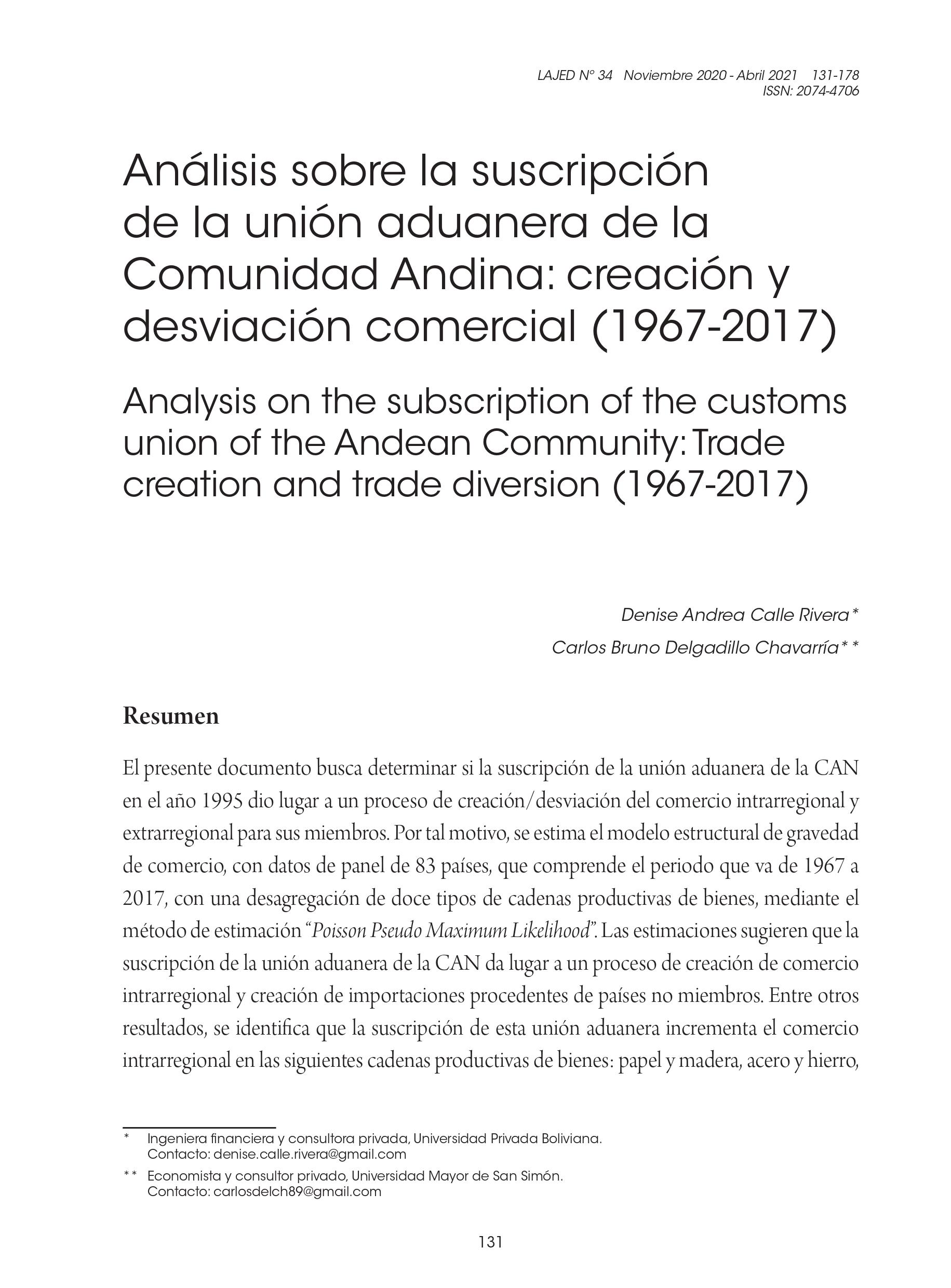Analysis on the subscription of the customs union of the Andean Community: Trade creation and trade diversion (1967-2017)
DOI:
https://doi.org/10.35319/lajed.202034428Keywords:
Regional trade agreement, Andean Community, intra-regional trade, extra-regional trade, structural gravity model of trade, Poisson Pseudo Maximum LikelihoodAbstract
This paper seeks to determine whether the signing of the CAN customs union in 1995 gave rise to a process of creation/diversion of intra-regional and extra-regional trade for its members. For this reason, estimates of the structural gravity trade model are developed, with panel data from 83 countries, which includes the period 1967-2017, with a disaggregation of twelve types of goods production chains, using the estimation method “Poisson Pseudo Maximum Likelihood”. Estimates suggest that signing the CAN customs union leads to a process of intraregional trade creation and the creation of imports from non-member countries. Among other results, the signing of this customs union increases intra-regional trade in the following productive chains of goods: paper and wood, steel and iron, non-ferrous metals and electronics. Also, it is identified that the groups of productive chains of energy, chemicals, vehicles and electric, a process of creation of exports to non-member countries is generated.
Downloads
References
Akram, M. y Rashid, Dr., A. (2016). Trade Creation and Diversion Effects of the European Union. Pakistan Journal of Applied Economics, Special Issue.
Anderson, J. E. y van Wincoop, E. (2004). Trade Costs. Journal of Economic Literature, 42(3), 691-751. Disponible en: https://doi.org/10.1257/0022051042177649
Arrieta, G. (2017). Un análisis gravitacional de la creación y desviación comercial en el marco del Tratado de Libre Comercio entre Perú y Estados Unidos. Serie Documentos de trabajo, Banco Central de Reserva de Perú.
Baier, S.; Bergstrand, J. y Walker, J. (2011). On the Endogeneity of International Trade Flows and Free Trade Agreements. Disponible en: https://www.researchgate.net/publication/237243299_On_the_Endogeneity_of_International_Trade_Flows_ and_Free_Trade_Agreements
Baier, S. L. y Bergstrand, J. H. (2009). Estimating the effects of free trade agreements on international trade flows using matching econometrics. Journal of International Economics, 77(1), 63-76. Disponible en: https://doi.org/10.1016/j.jinteco.2008.09.006
Baldwin, R. y Taglioni, D. (2006). Gravity for Dummies and Dummies for Gravity Equations. National Bureau of Economic Research. Working Paper Nº 12516. Disponible en: https://doi.org/10.3386/w12516
Banco Interamericano de Desarrollo (BID) (2018). Las nuevas tendencias en los acuerdos comerciales regionales. Módulos 1-5. Disponible en edx.
Bayoumi, T. y Eichengreen, B. (1997). Ever closer to heaven? An optimum-currency-area index for European countries. European Economic Review, 41(3), 761-770. Disponible en: https://doi.org/10.1016/S0014-2921(97)00035-4
Carrère, C. (2006). Revisiting the effects of regional trade agreements on trade flows with proper specification of the gravity model. European Economic Review, 50(2), 223-247. Disponible en: https://doi.org/10.1016/j.euroecorev.2004.06.001
Correia, S.; Guimarães, P. y Zylkin, T. (2019a). ppmlhdfe: Fast Poisson Estimation with High-Dimensional Fixed Effects. arXiv:1903.01690 [econ]. http://arxiv.org/abs/1903.01690
---------- (2019b). Verifying the existence of maximum likelihood estimates for generalized linear models. arXiv:1903.01633 [econ]. Disponible en: http://arxiv.org/abs/1903.01633
Coulibaly, S. (2009). Evaluating the Trade Effect of Developing Regional Trade Agreements: A Semi-parametric Approach. Journal of Economic Integration, 24(4), 709- 743, JSTOR.
Frankel, J. A. (1997). Regional Trading Blocs in the World Economic System. Peterson Institute for International Economics.
Gauto, V. F. (2012). An Econometric Analysis of Trade Creation and Trade Diversion in Mercosur: The Case of Paraguay. En 2012 Conference, August 18-24, 2012, Foz do Iguacu, Brazil (No 126864). International Association of Agricultural Economists. Disponible en: https://ideas.repec.org/p/ags/iaae12/126864.html
Johnson, H.G. (1960). The Economic Theory of Customs Union. Pakistan Economic Journal, (10), 14-32.
Kandogan, Y. (2005). Trade Creation and Diversion Effects of Europe’s Regional Liberalization Agreements (SSRN Scholarly Paper ID 681605). Social Science Research Network. Disponible en: https://doi.org/10.2139/ssrn.681605
Krugman, P. (1979). Increasing Returns, Monopolistic Competition, and International Trade. Journal of International Economics, 9(4), 469-479.
----------- (1980). Scale Economies, Product Differentiation, and the Pattern of Trade. The American Economic Review, 70 (5), 950-959.
Larch, M.; Wanner, J.; Yotov, Y. V. y Zylkin, T. (2017). The Currency Union Effect: A PPML Re-assessment with High-Dimensional Fixed Effects CESifo. Working Paper Nº 6464, Center for Economic Studies and Ifo Institute (CESifo), Munich. Disponible en: https://www.econstor.eu/bitstream/10419/161903/1/cesifo1_wp6464.pdf
MacPhee, C. R. y Sattayanuwat, W. (2014). Consequence of Regional Trade Agreements to Developing Countries. Journal of Economic Integration, 29(1), 64-94. Disponible en: https://doi.org/10.11130/jei.2014.29.1.64
Magee, C. S. P. (2008). New measures of trade creation and trade diversion. Journal of International Economics, 75(2), 349-362. Disponible en: https://doi.org/10.1016/j.jinteco.2008.03.006
Santos Silva, J. M. C. y Tenreyro, S. (2006). The Log of Gravity. The Review of Economics and Statistics, 88(4), 641-658. Disponible en: https://ideas.repec.org/a/tpr/restat/v88y2006i4p641-658.html
---------- (2010). On the existence of the maximum likelihood estimates in Poisson regression. Economics Letters, 107(2), 310-312. https://doi.org/10.1016/j.econlet.2010.02.020
---------- (2011). Further simulation evidence on the performance of the Poisson pseudo- maximum likelihood estimator. Economics Letters, 112(2), 220-222. Disponible en: https://ideas.repec.org/a/eee/ecolet/v112y2011i2p220-222.html
Tenreyro, S. (2019). The Log of Gravity page. Disponible en: http://personal.lse.ac.uk/tenreyro/lgw.html
Viner, J., (1950). The Customs Unions Issue. New York: Carnegie Endowment for International Peace.
Wanderley, F.; Benavides, J.; Vera, H.; Gantier, M. y Martínez, K. (2018). Hacia el desarrollo sostenible en la región andina: Bolivia, Perú, Ecuador y Colombia. Universidad Católica Boliviana San Pablo: Fundación Hans Seidel. Disponible en: http://www.iisec.ucb.edu.bo/assets_iisec/publicacion/Hacia_el_desarrollo_sostenible-web1.pdf
Yang, S. y Martínez-Zarzoso, I. (2014). A panel data analysis of trade creation and trade diversion effects: The case of ASEAN-China Free Trade Area. China Economic Review, 29(C), 138-151. Disponible en: https://doi.org/10.1016/j.chieco.2014.04.002
Yotov, Y. V.; Piermartini, R.; Monteiro, J. A. y Larch, M. (2016). An Advanced Guide to Trade Policy Analysis: The Structural Gravity Model. WTO. Disponible en: https://doi.org/10.30875/abc0167e-en






